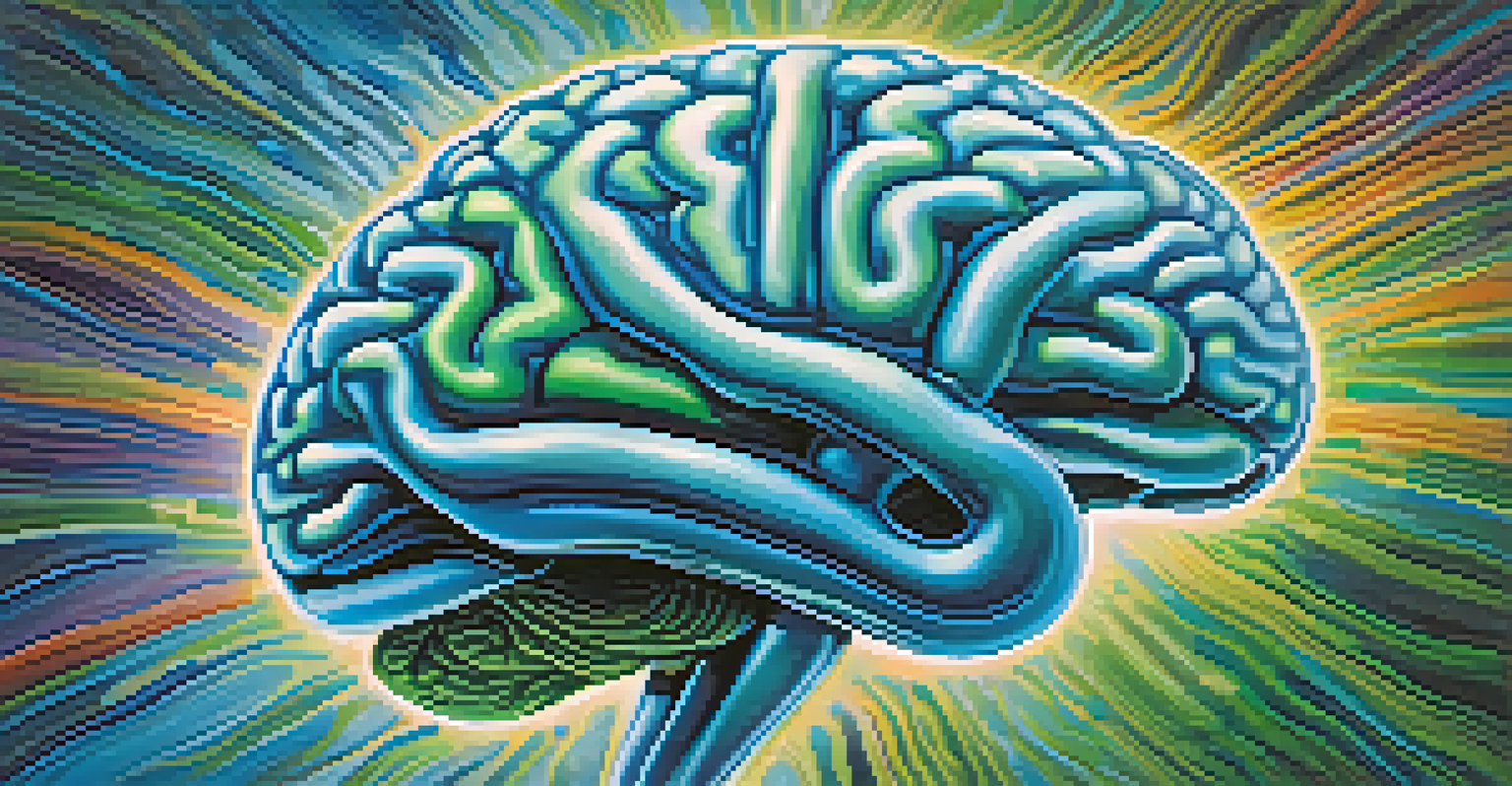The Neuroscience Behind Peyote-Induced Oneness

What is Peyote and Its Historical Significance?
Peyote, a small cactus native to Mexico and the United States, has been used for thousands of years in spiritual and ceremonial contexts. Indigenous peoples, including the Huichol and Navajo, have utilized this psychoactive plant to foster connections with the divine. The cactus contains mescaline, a compound known for its hallucinogenic effects that can alter perception and consciousness.
The journey of discovery is not in seeking new landscapes but in having new eyes.
These ceremonial uses of peyote aren't just about recreation; they serve a deeper purpose in promoting communal bonding and personal insight. Participants often report profound experiences that transcend the individual self, fostering a sense of oneness with nature and the universe. This cultural backdrop is essential to understand how peyote affects the mind and spirit.
As we delve into peyote's effects, it's crucial to recognize the intersection of culture, spirituality, and neuroscience. By studying how peyote influences brain activity, we can appreciate its role in facilitating mystical experiences and feelings of unity, which have been a cornerstone of many spiritual traditions.
The Brain's Role in Spiritual Experiences
The human brain is a complex organ, and its processes can sometimes feel mysterious, especially when it comes to spiritual experiences. Neuroimaging studies have shown that specific brain regions become active during profound moments of connection or transcendence. For instance, the default mode network (DMN), associated with self-referential thought, tends to show heightened activity during these experiences.

When someone consumes peyote, the resulting changes in brain activity can lead to feelings of unity and interconnectedness. These sensations are often described as overcoming the ego, where the lines between self and other begin to blur. This shift in perception can be deeply transformative, allowing individuals to experience a profound sense of belonging to something greater than themselves.
Peyote's Cultural and Spiritual Role
Peyote has been used for millennia by Indigenous peoples for spiritual ceremonies, fostering connections with the divine and promoting personal insight.
Understanding the neuroscience behind these experiences helps to demystify the feelings of oneness that many report. It's not merely a subjective experience; there are tangible changes occurring within the brain that facilitate these spiritual awakenings.
Mescaline: The Active Compound in Peyote
Mescaline, the primary psychoactive compound found in peyote, is responsible for its profound effects on perception and consciousness. It primarily works by interacting with serotonin receptors in the brain, particularly the 5-HT2A receptor, which plays a significant role in mood and perception. This interaction can lead to altered sensory experiences and changes in thought processes.
The mind is everything. What you think you become.
As mescaline influences brain chemistry, users often report vivid visual and auditory hallucinations, enhanced emotional responses, and a distorted sense of time. These alterations can facilitate a deeper connection to the self and the environment, further enhancing the sense of oneness. In this state, individuals may feel as if they are part of a larger cosmic tapestry.
Through understanding mescaline's action, we can appreciate how it enables users to access profound states of consciousness. This chemical interaction is a key player in the transformative experiences often associated with peyote ceremonies.
The Connection Between Oneness and Brain Function
When discussing the feelings of oneness induced by peyote, it's interesting to explore how these sensations correlate with brain function. Research suggests that during peak experiences, there is a decrease in activity within the brain's default mode network. This reduction allows for a less rigid sense of self, paving the way for interconnectedness and unity with the universe.
Furthermore, studies have indicated that increased communication between different brain regions occurs during these experiences. This heightened connectivity can lead to a blending of thoughts, emotions, and sensory perceptions, creating a holistic experience that transcends individual boundaries. Participants often describe this as a deep sense of love and connection to all living beings.
Mescaline's Impact on Perception
The psychoactive compound mescaline alters brain chemistry, leading to vivid hallucinations and enhanced emotional experiences that promote a sense of oneness.
By examining these neural interactions, we gain insight into the powerful effects of peyote on consciousness. The brain's ability to shift from a self-centered to a unified perspective illustrates the profound nature of these spiritual experiences.
Personal Experiences: Anecdotes of Oneness
Many individuals who have experienced peyote report transformative moments that profoundly reshape their understanding of existence. For instance, one user described a moment of clarity where they felt an overwhelming sense of love for everything around them, from nature to other people. This feeling of connectedness is often cited as one of the most impactful aspects of the peyote experience.
These personal stories offer insight into the subjective nature of oneness, highlighting how each individual's background and mindset can influence their journey. Some may encounter deep emotional healing, while others might gain insights into their purpose in life. These unique experiences speak to the versatility of peyote as a tool for personal and spiritual growth.
Ultimately, these anecdotes reinforce the idea that peyote can serve as a catalyst for deeper understanding and connection. The shared nature of these experiences illustrates a universal longing to belong and be part of something greater, a theme echoed across cultures and spiritual practices.
The Therapeutic Potential of Peyote Experiences
As interest in alternative healing methods grows, peyote's therapeutic potential cannot be overlooked. Research is beginning to highlight how peyote and other psychedelics can aid in treating mental health conditions such as depression, anxiety, and PTSD. The feelings of oneness and connection experienced during peyote use can foster healing and emotional resilience.
These therapeutic effects may stem from the brain's ability to rewire itself, a phenomenon known as neuroplasticity. By creating new neural pathways during profound experiences, peyote could help individuals process trauma and develop healthier coping mechanisms. This transformative potential is drawing attention from both the scientific community and mental health professionals.
Therapeutic Potential of Peyote
Emerging research suggests peyote may help treat mental health conditions by fostering emotional resilience and aiding in trauma processing through neuroplasticity.
However, it’s essential to approach this therapeutic use with caution and respect for the cultural significance of peyote. As we explore its benefits, we must also honor the traditions that have utilized peyote for centuries, ensuring that any therapeutic applications are both ethical and culturally sensitive.
Navigating the Future of Peyote Research
The future of peyote research holds immense promise, especially as society begins to embrace the potential benefits of psychedelics. Ongoing studies aim to further understand how peyote induces feelings of oneness and its implications for mental health treatment. As more research emerges, we may uncover new insights into the nature of consciousness and connection.
This research not only seeks to validate the experiences reported by peyote users but also aims to integrate these findings into therapeutic practices. By bridging the gap between traditional knowledge and modern science, we can create a more holistic understanding of the human experience. This integration may open doors for a broader acceptance of psychedelics in therapy and personal development.

In conclusion, as we navigate the complexities of peyote and its effects on the mind, we must remain open to learning from both scientific inquiry and cultural wisdom. The journey into the neuroscience of peyote-induced oneness is just beginning, promising to illuminate the profound connections that bind us all.